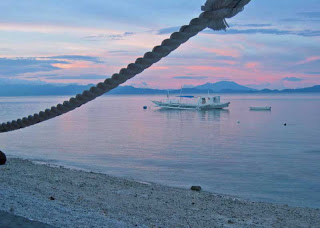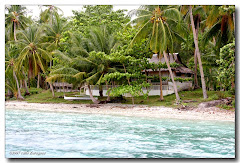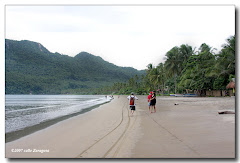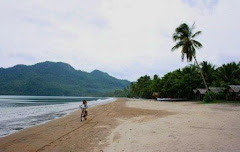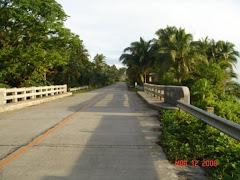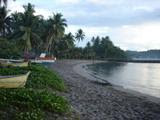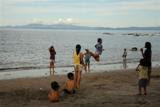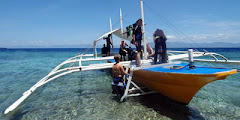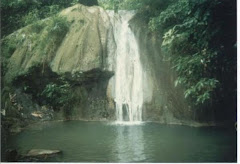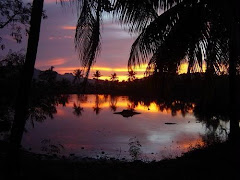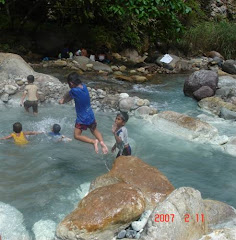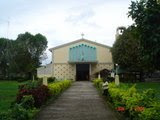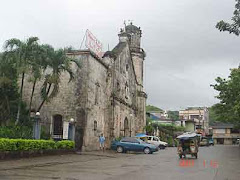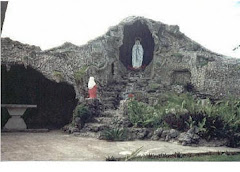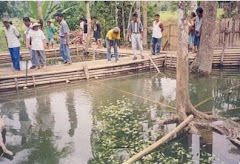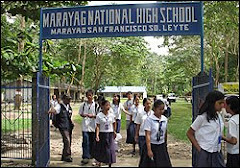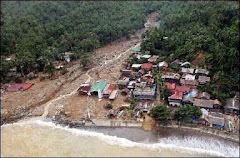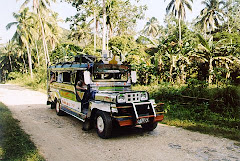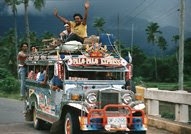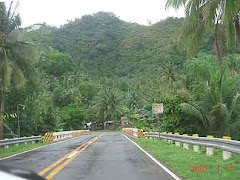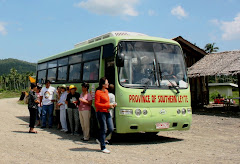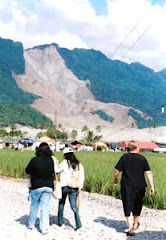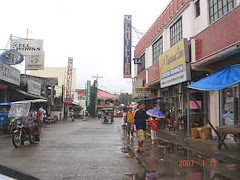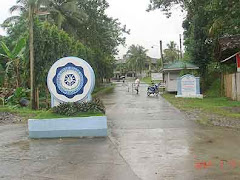Monday, March 24, 2008
The province of Southern Leyte lies on the south section of the main island. Surrounded by Leyte on the north, Leyte Gulf on the east, Camotes Sea on the west, and Surigao Strait on the south. The islands of Panaon and Limasawa are under its jurisdiction.The birthplace of Christianity in Asia and the site of the first mass on March 31, 1521 was held in the town of Limasawa. On March 22, 1959, by the Republic Act No. 2227, the island of Leyte was divided into Leyte and Southern Leyte provinces.Southern LeytePeople from Southern Leyte are "Boholano" breed. They speak both language of Cebuano and Boholano. Most of the villagers are farmers and fisher folks and are recognized to be hardworking, religious and moderate people.Agriculture is the main source of livelihood. Coconut, abaca, rice, sugarcane and banana are the major crops. Hog fattening is the main focus in its livestock production while poultry business pervades with broiler production.The Spanish era church is a prominent keystone that brings glory to the Leyteños. The church is decorated with a magnificent altar and beautiful images of saints. A revelation of the continuing religiosity of its people.Southern Leyte is blessed with beautiful sites. The town of Limasawa is a diver's paradise, along with Padre Burgos, San Francisco and Pintuyan. For trekkers and climbers, Patag Daku in Libagon poses as a major challenge.Other tourist attractions include caves of Cagnitoan and Guinsohotan,Spring in Anahawan & Also The Famous Running Man Resort located in Tahusan Hinunangan,Privately owned by Hollywood Movie actor.Access to the province can be by boat or bus. Ferryboats and fast passenger jetboats go to/from Maasin to/from Cebu, Mindanao and Negros. Buses and jeepneys are available anytime if you want to explore around the town.FACTSRegion: 8 Capital: MaasinLand Area: 1734.8 sq. km. Number of Towns: 191. Anahawan 2. Bontoc 3. Hinundayan 4. Hinunangan5. Libagon 6. Liloan7. Limasawa8. Maasin9. Macrohon10. Malitbog11. Padre Burgos12. Pintuyan13. Saint Bernard14. San Francisco15. San Juan 16. San Ricardo 17. Silago18. Sogod19. Tomas Oppus
Saturday, March 22, 2008
Friday, March 21, 2008
Southern Leyte
The province of Southern Leyte lies on the south section of the main island. Surrounded by Leyte on the north, Leyte Gulf on the east, Camotes Sea on the west, and Surigao Strait on the south. The islands of Panaon and Limasawa are under its jurisdiction.The birthplace of Christianity in Asia and the site of the first mass on March 31, 1521 was held in the town of Limasawa. On March 22, 1959, by the Republic Act No. 2227, the island of Leyte was divided into Leyte and Southern Leyte provinces.Southern LeytePeople from Southern Leyte are "Boholano" breed. They speak both language of Cebuano and Boholano. Most of the villagers are farmers and fisher folks and are recognized to be hardworking, religious and moderate people.Agriculture is the main source of livelihood. Coconut, abaca, rice, sugarcane and banana are the major crops. Hog fattening is the main focus in its livestock production while poultry business pervades with broiler production.The Spanish era church is a prominent keystone that brings glory to the Leyteños. The church is decorated with a magnificent altar and beautiful images of saints. A revelation of the continuing religiosity of its people.Southern Leyte is blessed with beautiful sites. The town of Limasawa is a diver's paradise, along with Padre Burgos, San Francisco and Pintuyan. For trekkers and climbers, Patag Daku in Libagon poses as a major challenge.Other tourist attractions include caves of Cagnitoan and Guinsohotan,Spring in Anahawan & Also The Famous Running Man Resort located in Tahusan Hinunangan,Privately owned by Hollywood Movie actor.Access to the province can be by boat or bus. Ferryboats and fast passenger jetboats go to/from Maasin to/from Cebu, Mindanao and Negros. Buses and jeepneys are available anytime if you want to explore around the town.FACTSRegion: 8 Capital: MaasinLand Area: 1734.8 sq. km. Number of Towns: 191. Anahawan 2. Bontoc 3. Hinundayan 4. Hinunangan5. Libagon 6. Liloan7. Limasawa8. Maasin9. Macrohon10. Malitbog11. Padre Burgos12. Pintuyan13. Saint Bernard14. San Francisco15. San Juan 16. San Ricardo 17. Silago18. Sogod19. Tomas oppus
As early as 1898 during the Spanish and American periods, there had already been existing as "sub-province" consisting of the municipalities from Palompon to Hinunangan, with Maasin as the center. Some government offices have already been established in Maasin on the southwestern part of Leyte to govern the area.
Historically, the governing city was the depository of cedula tax collections from Palompon to Hinunangan. This was administered by the office of the Administrado de Hacienda, equivalent to the Provincial Treasurer, a position under Secretario de Hacienda.
There was also established in Maasin a Court of First Instance, then known as the Promoter Fiscal, where all minor administrative and other cases from Palompon to Hinunangan were heard and disposed of.
During the Spanish colonization, the province was sparsely populated. The continued raiding of Moro slaves discouraged the province to grow and develop. However, on 19th century, immigrants from near provinces like Bohol and Cebu populated the area.
On 1942, Ruperto Kangleon held a conference in the town of Sogod, when the first attempt in Malitbog, a town to the east, failed to succeed due to many leaders stayed away. He was trying to unify all guerrillas helped to the Philippine Commonwealth troops during the outbreak of World War II.
On 1945, defenders to the Filipino Commonwealth soldiers and guerrillas attacked by the Japanese Imperial forces beginning to liberation in Southern Leyte, and the American troops landed in North in Leyte.
Due to change of sovereign powers, all the offices in Maasin except the Fiscal’s Office were abolished and reverted to Tacloban, the capital of Leyte. This created a major problem because of the dearth of transportation, the difficulty in managing the affairs of government in Tacloban and the language barrier between the Cebuano-speaking South-westerners and the Waray Easterners. The difficulty of managing the entire island from the main city suggested the need to separate the island into two provinces.
At first there was a general movement for a Western Leyte and soon after, many prominent men and leaders rallied behind the movement. Six attempts to pass a law for the division of Leyte were made. On the sixth attempt, then Congressman Nicanor Yñiguez introduced into the House a division law similar in substance to that of the Kangleon Bill, but recognizing the impossibility of creating an East-West Division, he instead opted to make his own district a province.
Abandoning the first bill, Congressman Nicanor Yñiguez presented House Bill No. 1318 proposing a new province of Southern Leyte comprising the Third Congressional District of Leyte to include 16 municipalities, from Maasin to Silago in the mainland, and in the Panaon Island.
The bill became Republic Act 2227 otherwise known as an "Act Creating the Province of Southern Leyte" and was signed into Law by President Carlos P. Garcia on May 22, 1959. On July 1, 1960, Southern Leyte was inaugurated as a province with sixteen municipalities and Maasin as the capital town. Thus the third District of Leyte became the province of Southern Leyte and Lone District of Southern Leyte.
As early as 1898 during the Spanish and American periods, there had already been existing as "sub-province" consisting of the municipalities from Palompon to Hinunangan, with Maasin as the center. Some government offices have already been established in Maasin on the southwestern part of Leyte to govern the area.
Historically, the governing city was the depository of cedula tax collections from Palompon to Hinunangan. This was administered by the office of the Administrado de Hacienda, equivalent to the Provincial Treasurer, a position under Secretario de Hacienda.
There was also established in Maasin a Court of First Instance, then known as the Promoter Fiscal, where all minor administrative and other cases from Palompon to Hinunangan were heard and disposed of.
During the Spanish colonization, the province was sparsely populated. The continued raiding of Moro slaves discouraged the province to grow and develop. However, on 19th century, immigrants from near provinces like Bohol and Cebu populated the area.
On 1942, Ruperto Kangleon held a conference in the town of Sogod, when the first attempt in Malitbog, a town to the east, failed to succeed due to many leaders stayed away. He was trying to unify all guerrillas helped to the Philippine Commonwealth troops during the outbreak of World War II.
On 1945, defenders to the Filipino Commonwealth soldiers and guerrillas attacked by the Japanese Imperial forces beginning to liberation in Southern Leyte, and the American troops landed in North in Leyte.
Due to change of sovereign powers, all the offices in Maasin except the Fiscal’s Office were abolished and reverted to Tacloban, the capital of Leyte. This created a major problem because of the dearth of transportation, the difficulty in managing the affairs of government in Tacloban and the language barrier between the Cebuano-speaking South-westerners and the Waray Easterners. The difficulty of managing the entire island from the main city suggested the need to separate the island into two provinces.
At first there was a general movement for a Western Leyte and soon after, many prominent men and leaders rallied behind the movement. Six attempts to pass a law for the division of Leyte were made. On the sixth attempt, then Congressman Nicanor Yñiguez introduced into the House a division law similar in substance to that of the Kangleon Bill, but recognizing the impossibility of creating an East-West Division, he instead opted to make his own district a province.
Abandoning the first bill, Congressman Nicanor Yñiguez presented House Bill No. 1318 proposing a new province of Southern Leyte comprising the Third Congressional District of Leyte to include 16 municipalities, from Maasin to Silago in the mainland, and in the Panaon Island.
The bill became Republic Act 2227 otherwise known as an "Act Creating the Province of Southern Leyte" and was signed into Law by President Carlos P. Garcia on May 22, 1959. On July 1, 1960, Southern Leyte was inaugurated as a province with sixteen municipalities and Maasin as the capital town. Thus the third District of Leyte became the province of Southern Leyte and Lone District of Southern Leyte.
Subscribe to:
Posts (Atom)





